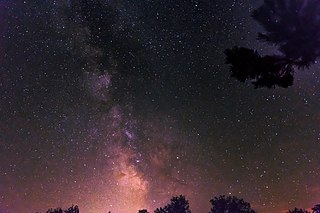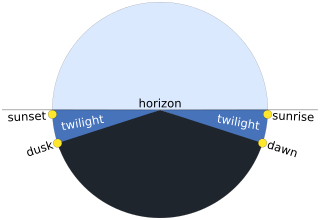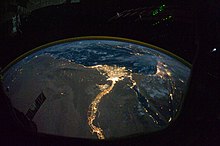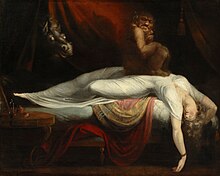A day is the time period of a full rotation of the Earth with respect to the Sun. On average, this is 24 hours. As a day passes at a given location it experiences morning, noon, afternoon, evening, and night. This daily cycle drives circadian rhythms in many organisms, which are vital to many life processes.

Dawn is the time that marks the beginning of twilight before sunrise. It is recognized by the appearance of indirect sunlight being scattered in Earth's atmosphere, when the centre of the Sun's disc has reached 18° below the observer's horizon. This morning twilight period will last until sunrise, when direct sunlight outshines the diffused light.

The sky is an unobstructed view upward from the surface of the Earth. It includes the atmosphere and outer space. It may also be considered a place between the ground and outer space, thus distinct from outer space.

In zoology, a crepuscular animal is one that is active primarily during the twilight period, being matutinal, vespertine/vespertinal, or both. This is distinguished from diurnal and nocturnal behavior, where an animal is active during the hours of daylight and of darkness, respectively. Some crepuscular animals may also be active by moonlight or during an overcast day. Matutinal animals are active only before sunrise, and vespertine only after sunset.

Twilight is light produced by sunlight scattering in the upper atmosphere, when the Sun is below the horizon, which illuminates the lower atmosphere and the Earth's surface. The word twilight can also refer to the periods of time when this illumination occurs.

A classical planet is an astronomical object that is visible to the naked eye and moves across the sky and its backdrop of fixed stars. Visible to humans on Earth there are seven classical planets. They are from brightest to dimmest: the Sun, the Moon, Venus, Jupiter, Mars, Mercury and Saturn.

In astronomy, an extraterrestrial sky is a view of outer space from the surface of an astronomical body other than Earth.

The night sky is the nighttime appearance of celestial objects like stars, planets, and the Moon, which are visible in a clear sky between sunset and sunrise, when the Sun is below the horizon.

Polar night is a phenomenon in the northernmost and southernmost regions of Earth where night lasts for more than 24 hours. This occurs only inside the polar circles. The opposite phenomenon, polar day, or midnight sun, occurs when the Sun remains above the horizon for more than 24 hours.

Evening is the period of a day that begins at the end of daylight and overlaps with the beginning of night. It generally indicates the period of time when the sun is close to the horizon and comprises the periods of civil, nautical and astronomical twilight. The exact times when evening begins and ends are subjective and depend on location and time of year. It may be used colloquially to include the last waning daytime shortly before sunset.

Diurnality is a form of plant and animal behavior characterized by activity during daytime, with a period of sleeping or other inactivity at night. The common adjective used for daytime activity is "diurnal". The timing of activity by an animal depends on a variety of environmental factors such as the temperature, the ability to gather food by sight, the risk of predation, and the time of year. Diurnality is a cycle of activity within a 24-hour period; cyclic activities called circadian rhythms are endogenous cycles not dependent on external cues or environmental factors except for a zeitgeber. Animals active during twilight are crepuscular, those active during the night are nocturnal and animals active at sporadic times during both night and day are cathemeral.

The Belt of Venus is an atmospheric phenomenon visible shortly before sunrise or after sunset, during civil twilight. It is a pinkish glow that surrounds the observer, extending roughly 10–20° above the horizon. It appears opposite to the afterglow, which it also reflects.
The luminaries were what traditional astrologers called the two astrological "planets" which were the brightest and most important objects in the heavens, that is, the Sun and the Moon. Luminary means, source of light. The Sun and Moon, being the most abundant sources of light to the inhabitants of Earth are known as luminaries. The astrological significance warrants the classification of the Sun and Moon separately from the planets, in that the Sun and Moon have to do with man's spiritual consciousness, while the planetary influences operate through the physical mechanism. The Moon is a luminary in the biblical sense that it affords to Man "light by night". Some early, Pre-Newtonian astronomers to observe and study luminaries include Pythagoras, Aristotle, Claudius Ptolemy, al-Khwarizmi, Nicolaus Copernicus, Tycho Brahe, Galileo Galilei, and Johannes Kepler.

The biological and geological future of Earth can be extrapolated based on the estimated effects of several long-term influences. These include the chemistry at Earth's surface, the cooling rate of the planet's interior, the gravitational interactions with other objects in the Solar System, and a steady increase in the Sun's luminosity. An uncertain factor is the pervasive influence of technology introduced by humans, such as climate engineering, which could cause significant changes to the planet. For example, the current Holocene extinction is being caused by technology, and the effects may last for up to five million years. In turn, technology may result in the extinction of humanity, leaving the planet to gradually return to a slower evolutionary pace resulting solely from long-term natural processes.

The Rayleigh sky model describes the observed polarization pattern of the daytime sky. Within the atmosphere, Rayleigh scattering of light by air molecules, water, dust, and aerosols causes the sky's light to have a defined polarization pattern. The same elastic scattering processes cause the sky to be blue. The polarization is characterized at each wavelength by its degree of polarization, and orientation.

Earth's shadow is the shadow that Earth itself casts through its atmosphere and into outer space, toward the antisolar point. During the twilight period, the shadow's visible fringe – sometimes called the dark segment or twilight wedge – appears as a dark and diffuse band just above the horizon, most distinct when the sky is clear.

Ecological light pollution is the effect of artificial light on individual organisms and on the structure of ecosystems as a whole.

The theorized habitability of red dwarf systems is determined by a large number of factors. Modern evidence indicates that planets in red dwarf systems are unlikely to be habitable, due to their low stellar flux, high probability of tidal locking and thus likely lack of magnetospheres and atmospheres, small circumstellar habitable zones and the high stellar variation experienced by planets of red dwarf stars. However, the sheer numbers and longevity of red dwarfs could provide ample opportunity to realize any small possibility of habitability.

A moon garden, also known as a twilight garden, evening garden, night garden, moonlight garden, or dream garden, is a type of garden designed to be enjoyed at dusk and nighttime. Fragrant flowers, light-colored vegetation or blooms that are visible by moonlight, blossoms that open at night instead of day, and plants which attract night pollinators you can hear, are all elements of a moon garden. The different effects produced by moonlight compared to sunlight in human color perception emphasize the colors of certain flowers more than others, bringing out different tones which are not available during daytime or with artificial lights. Night-blooming plants are typically moth, bat or wind pollinated. Planning an evening garden can perform double-duty as a setting for evening entertaining such as barbecues and parties.





























